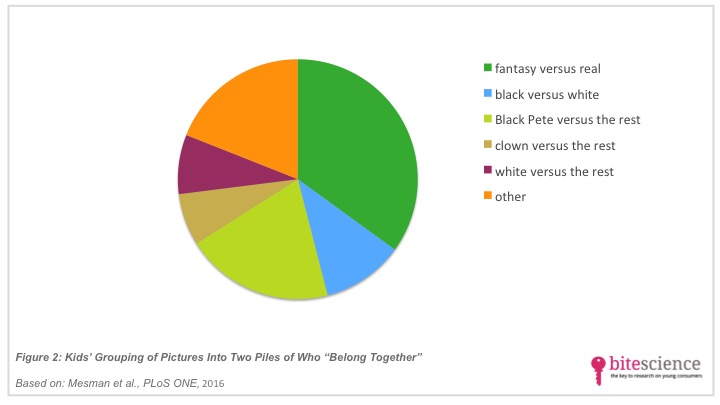
Kids see Black Pete as a Friendly Fantasy Figure
For Dutch kids, December 5th is one of the most exciting days of the year. On that day, children receive presents from Sinterklaas—an elderly white bishop who rides on his horse Americo. All the gifts are bought, packed, and distributed by his helpers called Black Petes, who have dark painted faces, red lips, and wear afro wigs. The racial stereotypical appearance of Black Pete and his subordinate role to Sinterklaas have caused much debate. Some are worried that the portrayal of Black Pete might have negative effects on children’s opinions about black people. A study in PLoS ONE explored children’s view on Black Pete and found that they primarily see him as a friendly fantasy figure.
Take aways
- Dutch kids are aware of Black Pete’s skin color and his subordinate status to Sinterklaas.
- Kids associate Black Pete more often with fantasy figures such as clowns than with real people.
- They assign many positive traits to Black Pete.
- This suggests that Dutch Children primarily see Black Pete as a friendly fantasy figure.
- These conclusions do neither confirm nor take away concerns about the stereotypical portrayal of Black Pete
Study information
The question?
Are kids aware of Black Pete’s skin color and subordinate status and how do kids categorize and evaluate Black Pete in relation to fantasy and real characters?
Who?
201 families with children of 5 (39%), 6 (34%), or 7 (26%) years old; half of the parents (51%) were highly educated and the majority of the families (77%) came from predominantly white neighborhoods.
Where?
The Netherlands
How?
Families were recruited through Facebook and the networks of the research assistants. Only families with children between 5 and 7 years of age could participate, as this group of children still believes Sinterklaas exists yet is old enough to complete the tasks. Of the participating families, one parent answered online questions about the family’s background (e.g., education level, neighborhood composition, ethnic salience in kids’ lives) and their opinions about Black Pete.
Next, research assistants visited the families and administered three tasks. First, kids were asked to describe Black Pete in response to the questions “Who is Black Pete?” and “What does he do, what does he look like?”. Their first answers were categorized as (1) has a dark skin color, (2) has other distinctive characteristics, such as colorful clothes, (3) brings presents, (4) is a helper of Sinterklaas, or (5) other (e.g., comes through the chimney). Then the kids were shown pictures of Black Petes, clowns, black people, and white people (3 pictures of each group), which they had to sort into two piles of who “belong together”. Finally, kids were given 20 different cards indicating various characteristics that were read out loud by the research assistants. Their task was to assign the 20 labels, which could be positive (e.g., nice, smart, important), negative (e.g., mean, naughty, boss), and reflecting a black person stereotype (e.g., dumb, lazy, helper) to the four types of pictures of the previous task.
Facts and findings
- When asked to describe Black Pete, the largest group of kids (39%) first mentioned his skin color. Other initial descriptions included (see Figure 1):
- brings presents (19%);
- is a helper of Sinterklaas (11%);
- has a distinct appearance (10%);
- other (20%).
- When sorting the four types of pictures into two piles, the largest group of kids (35%) sorted them as fantasy versus real, putting Black Petes and clowns in one pile and the black and white people in the other. Other combinations were (see Figure 2):
- black versus white (11%);
- Black Pete versus the rest (20%);
- clown versus the rest (7%);
- white versus the rest (8%);
- other (19%).
- When assigning labels to the four types of pictures, Black Pete received the most positive characteristics (see Figure 3).
- Critical note: in this study participated an above average amount of parents with a high education level, meaning that the sample was not representative for the larger population of Dutch families. This limits the extent to which the results can be generalized to other types of families in the Netherlands.


